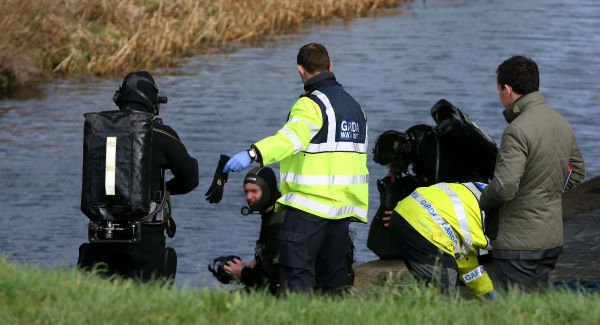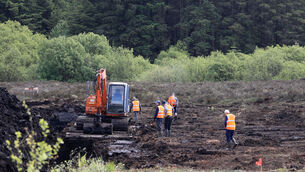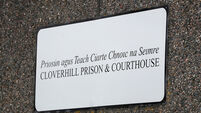Jury to resume deliberations in morning on man accused of murdering friend and then dismembering him

A Central Criminal Court jury will resume deliberations tomorrow in the trial of a murder accused, who ‘chopped’ his friend up with a chainsaw after shooting him in the defendant’s back yard.
Before it retired, the judge reminded the jury of seven coincidences that the defence said supported the accused man’s story that he shot his friend during a scuffle over the deceased asking him to murder the mother of his child.
Paul Wells Snr (50) of Barnamore Park, Finglas has admitted shooting dead fellow Dubliner Kenneth O’Brien and dismembering his body.
However, he has pleaded not guilty to murdering the 33-year-old at his home in Barnamore Park on 15th or 16th January, 2016.
The father-of-five claims that the deceased had wanted him to murder Mr O’Brien’s partner, so that he could take their child back to Australia, where he had previously lived.
He told gardai that Mr O’Brien had brought a gun to his house for this purpose on the evening of the 15th but that he didn’t want to do it. He said this resulted in a scuffle between them, that the gun fell, they both tried to get it, but that he got to it first and shot his friend in the back of the head.
He said that he then panicked, ‘chopped him into pieces’ with a chainsaw Mr O’Brien had lent him, put his torso into Mr O’Brien’s suitcase and dumped it in the Grand Canal.
Mr Justice Paul McDermott began charging the jury on Friday and concluded yesterday (Monday).
He reminded the 11 jurors of matters that Michael O’Higgins SC, defending, had said supported his client’s defence that there was a conspiracy to murder Mr O’Brien’s partner, Eimear Dunne.
Mr O’Higgins had referred to them as a series of coincidences that arose on the very day that Mr O’Brien had allegedly intended to have his partner killed.
These included the fact that the CCTV system in the couple’s home was not working that day and that its code had been changed, something Ms Dunne said that only Mr O’Brien could have done.
There was the cancellation, by Mr O’Brien, of Ms Dunne’s 30th birthday party that night; he had said he was working in Limerick that day, but this work was also cancelled.
The judge also reminded the jury that Mr O’Brien had no house keys, but had cut some the previous day, that he ‘had two phones on the go’, and that his passport was missing at the time of his death.
He also noted that Mr O’Higgins had argued that Mr O’Brien had given suitcases to Mr Wells, one of which was handed over at the boot of a car, with him allegedly telling Mr Wells that he didn’t want Ms Dunne to know about it.
Finally, he noted that the numbers for two of Mr O’Brien’s employers had been removed from Ms Dunne’s phones.
The judge explained that the defence case was that these coincidences supported the proposition that there was a conspiracy to murder Ms Dunne. He reminded the jury that the prosecution had argued that there was premeditation in the killing of Mr O’Brien.
The 11 members were given three possible verdicts: guilty, not guilty of murder but guilty of manslaughter, or acquittal, and were told to reach a unanimous decision.
They began considering their verdict shortly after noon and had deliberated around three hours before going home for the evening. They will resume deliberations this morning.

Disturbing elements
Last week the trial judge noted the ‘disturbing elements’ relating to the disposal of the body in a case where the accused said he ‘chopped’ his friend up with a chainsaw after shooting him dead in self defence.
However, he told the jury that the ‘horror’ shouldn’t determine its verdict, with the main issue to decide being how his death was brought about.
“In this case, there are disturbing elements in relation to the disposal of the body,” said Mr Justice McDermott, as he began his charge yesterday.
“The main issue in this case is how the deceased died, how was his death brought about, what were the circumstances of his death,” he explained.
“Maybe some of the matters after his death assist you in determining that fact, but the horror that might have been felt at what happend shouldn’t necessarily determine the guilt or innocence of Mr Wells,” he continued.
“It’s only if it informs you of what happend at the time he was killed that it becomes relevant.”
He told the jury to consider the state of mind in which the killing was done, whether it was intended or not, or was self defence or not.
However, he told the jury that it could consider something done afterwards to cover his tracks ‘if it’s suggested that it indicates state of mind on the part of the perpetrator’.
He said that it was for the jury to decide if Mr Wells had intended to cause death or serious injury when discharging the firearm into the back of Mr O’Brien’s head.
He said that if the jury was satisfied beyond reasonable doubt that Mr Wells was the aggressor and that this was a planned assassination, that would be murder.
He explained that a homicide was not murder if committed in reasonable self defence.
He told the jurors that they had to consider all the evidence in the case, how Mr O’Brien came to be at Mr Wells’ house, why he was there, what happeend, what ensued after he arrived, the nature of the row or fight that Mr Wells described, his description of the gun falling to the ground, the struggle to get that gun and the accused man’s ‘state of mind when he got that gun’.
He said that if they reached a view that Mr Wells was in a situation that justified the use of some force, but he used more force than he knew to be reasonably necessary, the appropriate verdict would be guilty of murder. He said the jury was also entitled to conclude that he did not believe any force was necessary.
“If Mr Wells killed Mr O’Brien because he honestly believed that the level of force that he used in discharging the gun into the back of his head was, in that time and place, necessary to defend himself, but in doing so used a greater degree of force than a reasonable man would have considered necessary, the appropriate verdict in that situation would be not guilty of murder but guilty of manslaughter,” he explained.
He said that a full defence to murder was open if he killed Mr O’Brien using such force as was, in the circumstances, reasonably necessary.
“If there’s a reasonable possibility that hasn’t been excluded by the prosecution, you simply acquit him,” he said.
He explained that if one man attacked the other, the other man had the right to strike a blow in his own defence without waiting to be struck.
The jury had earlier heard the conclusion of the defence’s closing speech.
Michael O’Higgins SC told the jurors that one of the things they’d do when deliberating would be to use their common sense.
“It’s very good advice, but in certain cases common sense has its limitation,” he said. “The realm of this case as put forward by the prosecution and the defence is way outside everybody’s ordinary daily living.”
He asked them to keep that to the fore and not rush to any conclusions.
“It would be wrong to convict Mr Wells because you think he's despicable,” he said. “It would be equally wrong to acquit him because you took some set against Mr O'Brien.”
He asked where the evidence was to disprove his client’s account of landing behind the deceased in a ‘row-your-boat’ position during the scuffle and immediately before the shooting. He asked where a ballistics expert was to give an indication of the possible explanations for the slightly downward trajectory of the bullet.
He noted the pathology evidence that the weapon had been pressed against the back of the head at the time of the shooting.
“If people are struggling on the ground and there’s a battle for the gun and people are moving, I suggest it’s ... possible the head and gun could come in contact,” he said.
He suggested that it was equally possible that, in the heat of that tussle, a gun could be applied to the head and discharged.
He said that the real question was whether it was reasonably possible that ‘if it wasn’t going to be Mr O’Brien, it was going to be Mr Wells’. If the answer was yes, there should be an acquittal, he explained.
However, if they found that Mr Wells had over-reacted, then the verdict should be manslaughter, he concluded.












